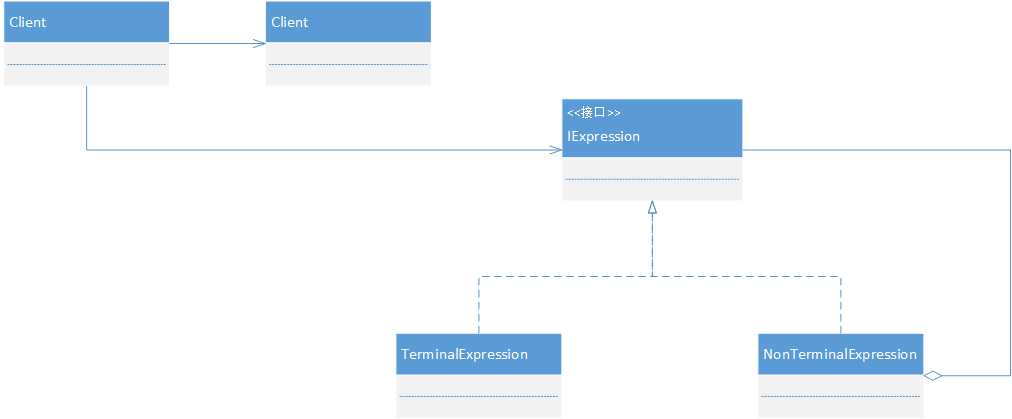标签:
解释器模式,简单来讲就是一个简版的编译器,如果一种特定类型的问题发生的频率足够高,那么可能就值得将该问题的各个实例表述为一个简单语言中的句子。解释器模式能对一些较频率执行的文法转换为一种特定的文法类型,不过解释器模式也有其不足,就是如果文法较为复杂的话,就得需要将每一个文法转换成至少一个类,如果包含许多规则的文法可能难以维护和管理。这个时候就需要其他的技术,就是我们最开始提到的语法分析程序或编译器来处理。
解释器模式的基本类结构图很简单,最基本的实现也很简单。

1 package day_13_interpreter; 2 3 /** 4 * 包含解释器之外的一些全局信息,或者说这就是解释器要解释得文法 5 * @author 余林丰 6 * 7 * 2016年10月13日 8 */ 9 public class Context { 10 11 }
1 package day_13_interpreter; 2 3 /** 4 * 解释器接口 5 * @author 余林丰 6 * 7 * 2016年10月13日 8 */ 9 public interface IExpression { 10 void interpret(Context context); 11 }
1 package day_13_interpreter; 2 3 /** 4 * 非终结符表达式,为文法中的非终结符实现解释操作。对每一条规则都要有一个非终结符表达式。 5 * @author 余林丰 6 * 7 * 2016年10月13日 8 */ 9 public class NonterminalExpression implements IExpression { 10 11 /* (non-Javadoc) 12 * @see day_13_interpreter.IExpression#interpret(day_13_interpreter.Context) 13 */ 14 @Override 15 public void interpret(Context context) { 16 System.out.println("非终结符解释器"); 17 } 18 19 }
1 package day_13_interpreter; 2 3 /** 4 * 终结符表达式,实现与文法中的终结符相关联的解释操作 5 * @author 余林丰 6 * 7 * 2016年10月13日 8 */ 9 public class TerminalExpression implements IExpression { 10 11 /* (non-Javadoc) 12 * @see day_13_interpreter.IExpression#interpret(day_13_interpreter.Context) 13 */ 14 @Override 15 public void interpret(Context context) { 16 System.out.println("终结符解释器"); 17 } 18 19 }
1 package day_13_interpreter; 2 3 import java.util.ArrayList; 4 import java.util.List; 5 6 /** 7 * @author 余林丰 8 * 9 * 2016年10月13日 10 */ 11 public class Client { 12 13 public static void main(String[] args){ 14 Context context = new Context(); 15 List<IExpression> list = new ArrayList<IExpression>(); 16 list.add(new TerminalExpression()); 17 list.add(new NonterminalExpression()); 18 list.add(new TerminalExpression()); 19 list.add(new TerminalExpression()); 20 21 for (IExpression expression : list){ 22 expression.interpret(context); 23 } 24 } 25 26 }
标签:
原文地址:http://www.cnblogs.com/yulinfeng/p/5958724.html